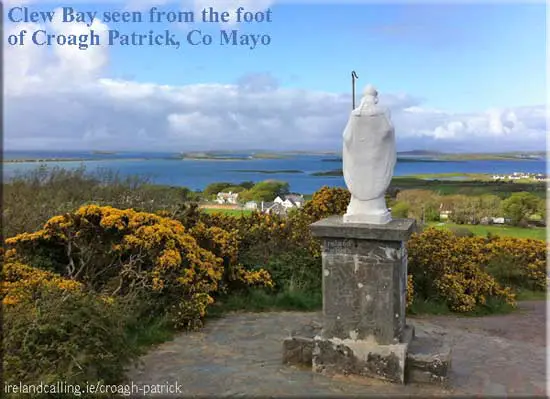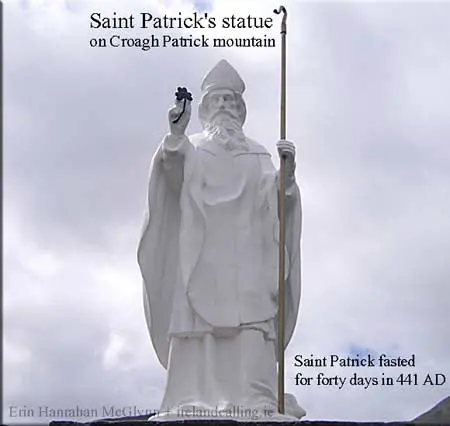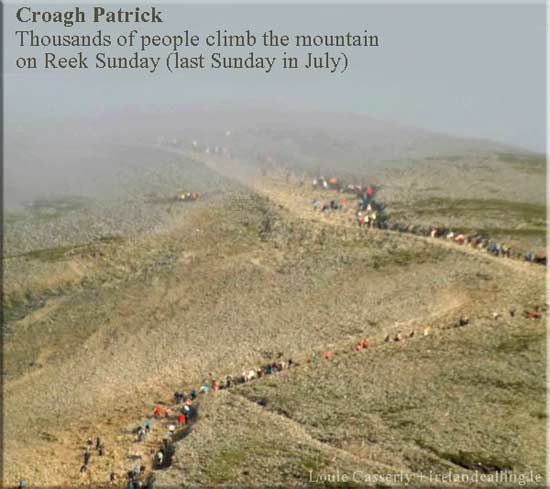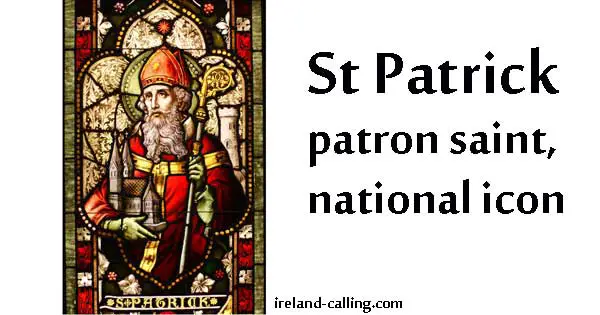St Patrick is the Patron Saint of Ireland and is credited with having established Christianity in the country more than 1500 years ago.
His story is partly fact, partly legend and partly and merging of the two. In popular imagination he is remembered for supposedly ridding the country of snakes. He is said to have explained the concept of the Holy Trinity by likening it to a shamrock, and in the process turning a small clover into a symbol for Ireland.
He is said to have debated with Celtic druids and talked with mythical Celtic figures in stories which are highly entertaining if not reliable.
What is certain is that he orchestrated the seismic shift that saw Ireland abandon the pagan religions that had dominated the country for centuries, and adopt the Christian religion that would dominate it for centuries to come.
It was a remarkable achievement, even when the legendary elements are stripped out, making St Patrick one of the most important figures in Irish history.
Documented evidence – The Confessio and the Letter against Coroticu
Much of what we know about him comes from two documents that he wrote once he was established as the head of the church in Ireland. The Confessio describes aspects of his life and how he came to be in Ireland; the Letter against Coroticus is a protest against the slaughter of Christians by a raiding party from Roman Britain.
In Confessio he describes how he was the son of Roman official called Calpornius living in Britain. He doesn’t specify dates so it is difficult to be precise about when he lived other than to say it was during the 5th century.
During this period, Roman power was on the wane throughout Europe. They were losing their iron grip on Britain, which encouraged Irish pirates and raiding parties to mount smash and grab attacks on unguarded British towns.

The young Patrick was captured by Irish raiders
In the Confessio, Patrick says that when he was 16 he was captured by Irish raiders who attacked his home at Bannaventium Taburniae. Scholars can’t place this precisely but most agree it was somewhere on the west side of Britain, possibly Wales.
The raiders took Patrick back to Ireland and sold him into slavery. He was taken about 200 miles west, possibly to Co Mayo, where he was made to herd cattle and sheep for six years.
The Roman Empire was Christian by the 5th century but Patrick says he was not religious at this time and had little faith. However, in his isolation and despair, he began to find comfort in God. He wrote:
‘The love of God and the fear of Him came to me more and more, and my faith increased, and my spirit was stirred, so that in one day I used to say up to 100 prayers and at night as many more, and I stayed in the forests and on the mountains, and before daylight I used to be roused to prayer in snow and frost and rain.’
God spoke to Patrick
After six years in Ireland, Patrick describes how he heard a voice telling him to escape and return home. A ship would be waiting for him when he arrived at the shore. Patrick took this to be the voice of God and obeyed immediately.
He walked the 200 miles, careful to avoid recapture, until he arrived at the Irish Sea. As the voice had predicted, there was a ship ready to sail and Patrick managed to persuade the captain to take him on board.
He eventually made it back home and was reunited with his parents. He then returned to his education, determined to make up for lost time.
He sat in classes with children much younger than he was and was embarrassed by his poor standard in Latin. “I have not studied like the others,” he later wrote in Confessio.
Patrick did eventually catch up and was ordained as a priest.

Vox Hiberniae – the Voice of the Irish
Throughout this time, Patrick describes how he never forgot his time in Ireland and the people he had met. He had another dream in which he saw a man coming from Ireland. The man handed him a letter with the heading, Vox Hiberniae – the Voice of the Irish.
He said that as he read the letter, he heard the people he had known in Ireland calling to him: “We beg you, holy boy, to come and walk among us once again.”
The memory of the voices he heard in the dream stayed with him for many years.
He wrote: It completely broke my heart, and I could read no more and woke up.”
Patrick said the dream left him in no doubt as to what he had to do: return to Ireland to preach the Gospel and convert the Irish to Christianity.
St Patrick – Bishop of the Irish
His wish came true when the Roman church in Britain appointed him Bishop of the Irish, and sent him to nurture and expand Ireland’s growing Christian community.
Patrick says virtually nothing about his achievements in Ireland and his humility means it is difficult to establish when he arrived, what he did and where he visited.
However, most scholars believe he arrived back in Ireland in 432 and spent most of his time working in the north. He established the diocese of Armagh which was to be a major seat of Christianity for centuries to come.
He also preached tirelessly across the region and was particularly prominent in Templepatrick, Saul, Downpatrick, Lough Derg and Croagh Patrick – all of which became closely associated with him and in some cases took his name.

Uí Néill dynasty ensured his safety
In order to succeed, Patrick would almost certainly have needed the support of the Irish kings and clan leaders. The Uí Néill dynasty were the dominant force in the north and it’s likely they adopted him and ensured his safety.
He was clearly pleased with the reception he received and the success of his mission for he wrote:
“I cannot be silent about the great benefits and the wonderful grace that the Lord has deigned to bestow upon me in the land of my captivity.”
Patrick’s mission was not without its setbacks. He was dismayed and furious when a group of his Irish converts were slaughtered by a raiding party of Christians from Britain led by Coroticus. Patrick wrote a letter in protest to Coroticus in which he described how the converts were:
“newly baptised, in their white clothing – the oil still shining on their heads – cruelly butchered and slaughtered by the sword…oh greedy wolves, they have gorged themselves with the congregation of the Lord, which was increasing so well in Ireland, with the closest care, and made up of the sons of Irish raiders and the daughters of kings who had become monks and virgins of Christ. I cannot say how many. So may the wrong done not please you! And even into hell may it give you no pleasure.”
Church structure reverted to monastries
Christianity survived and thrived thanks to the work of St Patrick but the church structure he established did not. He had tried to set up a diocesan structure based on parishes. This worked well in Europe but not in Ireland because there were no towns on which to base it.
After St Patrick’s death, the church took a different turn with monasteries being the main centres rather than parishes and dioceses. This became the norm in Ireland for several centuries.
St Patrick gave Christianity a firm foundation in Ireland that survives to this day. In the process he became national icon whose name is synonymous with Ireland. St Patrick’s Day is celebrated all across the world, and although those celebrations have little to do with religion, they still show how important a figure St Patrick is to Ireland.

Irish History – quick, easy-to-read summaries
